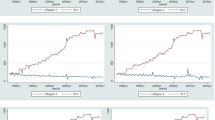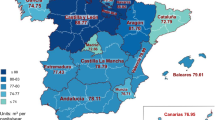Abstract
This paper explores the influence of regional climate variability on the elasticity of price for residential water demand in Spain. The data comes from the Spanish Survey of Family Budget (INE 2012), a national based survey of household living conditions including more than 15,000 observations. The econometric analysis included other determinants of residential water demand in Spain such as income and household characteristics. In line with the broad literature, the demand for water in Spain is found to be inelastic, although price elasticity differs notably when accounting for different climatic regions in the territory. The results have noteworthy policy implications as water pricing is considered an efficient means of long term sustainable planning of water resources management. The results imply that policy makers may have reasons to explore differentiating the impacts of water efficiency measures by region.
Similar content being viewed by others
Notes
The approval of the European Directive in 2000 established a paradigmatic shift in the public management of water resources, not only in regards to its main objective (i.e. improving the environmental quality of European waters) but in the use of economic analysis as one of the main pillars for its implementation (Union 2000; Kristensen et al. 2013; Tsakiris 2015).
There is a growing theoretical literature suggesting that income elasticity is unlikely to be constant (Barbier et al. 2016). As suggested by an anonymous reviewer, other non-linear more flexible relationships, such as Box-Cox transformation of dependent and explanatory variables, were investigated. However, we found a non-significant lambda parameter suggesting that the semi-logarithmic functional form fits the data best in this particular setting.
White’s (1980) test is used to test the presence of heteroscedasticity in the error term and, under the null hypothesis of homoscedasticity, the test value is Chi2 (181) = 679.95 (p value <0.001). Therefore, we reject the null hypothesis and display robust standard errors.
Population indicators are often used in the literature to instrumentalise prices. Schleich and Hillenbrand (2009) use natural logarithm of population and population density as instruments.
The income elasticity is calculated computing the mean of the individual-specific elasticities using household income level.
In a previous model excluding climatic conditions we found statistically significant differences in water demand between regions in Spain: compared with the Central region, warmer regions (i.e. Western, Southern and Canary Islands) were found to have statistically significant higher water demand and colder regions (Northern) lower.
Variable HOTWATER is not a good instrument for PRICE in the regression of the East Region according to Wooldridge’s (1995) robust score test. As a consequence, RENTALPERICEm2 is used as a second instrument in the East Region. RENTALPERICEm2 is the mean rent price for m2 of a house with the same characteristics (province, size, residential area, type of building).
References
AEMET (2015) Datos climatológicos 1980–2010. AEMET, Agencia Española de Meteorología, Madrid
Agthe DE, Billings B, Dobra JL, Raffiee K (1986) A simultaneous equation demand model for block rates. Water Resour Res 22:1–4
Arbues F, Villanua I (2006) Potential for pricing policies in water resource management: estimation of urban residential water demand in Zaragoza, Spain. Urban Stud 43:2421–2442. doi:10.1080/00420980601038255
Arbués F, Barberán R, Villanúa I (2004) Price impact on urban residential water demand: a dynamic panel data approach. Water Resour Res 40:W11402. doi:10.1029/2004WR003092
Barbier EB, Czajkowski M, Hanley N (2016) Is the income elasticity of the willingness to pay for pollution control constant? Environ Resour Econ:1–20. doi:10.1007/s10640-016-0040-4
Barros VR, Field CB (eds) (2015) Climate change 2014 – impacts, adaptation and vulnerability: part B: regional aspects. Cambridge University Press, New York
Basmann RL (1960) On finite sample distributions of generalized classical linear identifiability test statistics. J Am Stat Assoc 55:650–659
Billings B (1982) Specification of block rate price variables in demand models. Land Econ 58:386–394
Billings B (1987) Alternative demand model estimations for block rate pricing. Water Resour Bull 23:341–345
Billings B, Agthe DE (1980) Price elasticities for water: a case of increasing block rates. Land Econ 56:73–84
Carvalho M, Serralheiro R, Corte-Real J, Valverde P (2015) An analysis of the price escalation of non-linear water tariffs for domestic uses in Spain. Water Util J:13–18
Dalhuisen JM, Florax RJ, De Groot HL, Nijkamp P (2003) Price and income elasticities of residential water demand: a meta-analysis. Land Econ 79:292–308
Dandy G, Nguyen T, Davies C (1997) Estimating residential water demand in the presence of free allowances. Land Econ 73:125–139. doi:10.2307/3147082
EEA (2013) Assessment of cost recovery through pricing of water. Publications Office of the European Union, EEA (European Environment Agency), Luxembourg, p. 2013
Espey M, Espey J, Shaw WD (1997) Price elasticity of residential demand for water: a meta-analysis. Water Resour Res 33:1369–1374. doi:10.1029/97WR00571
European Union (2000) Directive 2000/60/EC of the European Parliament and of the council of 23 October 2000 establishing a framework for community action in the field of water policy. Off J Eur Communities, 22 December 2000 (2000) L327/1-L327/72.
Frondel M, Messner M (2008) Price perception and residential water demand: evidence from a German household panel. In: 16th annual conference of the European association of environmental and resource economists in Gothenburg. pp 25–28
Garcia S, Reynaud A (2004) Estimating the benefits of efficient water pricing in France. Resour Energy Econ 26:1–25
García-Ruiz JM, López-Moreno JI, Vicente-Serrano SM et al (2011) Mediterranean water resources in a global change scenario. Earth-Sci Rev 105:121–139. doi:10.1016/j.earscirev.2011.01.006
García-valiñas MA (2005) Efficiency and equity in natural resources pricing: a proposal for urban water distribution service. Environ Resour Econ 32:183–204. doi:10.1007/s10640-005-3363-0
Gaudin S (2006) Effect of price information on residential water demand. Appl Econ 38:383–393
Grafton RQ, Ward MB, To H, Kompas T (2011) Determinants of residential water consumption: Evidence and analysis from a 10-country household survey. Water Resour Res 47(8):1–14. doi:10.1029/2010WR009685
Griffin RC, Chang C (1990) Pretest analysis of water demand in thirty communities. Water Resour Res 26:2251–2255
Höglund L (1999) Household demand for water in Sweden with implications of a potential tax on water use. Water Resour Res 35:3853–3863. doi:10.1029/1999WR900219
INE (2012) Encuesta de Presupuestos Familiares. INE, Instituto Nacional de Estadística, Madrid
Kristensen P, Luche Solheim A, Austnes K (2013) The water framework directive and state of Europe’s water. Eur Water:3–10
Lyman RA (1992) Peak and off-peak residential water demand. Water Resour Res 28:2159–2167. doi:10.1029/92WR01082
Martínez-Espiñeira R (2002) Residential water demand in the northwest of Spain. Environ Resour Econ 21:161–187
Martínez-Espiñeira R (2003) Estimating water demand under increasing-block tariffs using aggregate data and proportions of users per block. Environ Resour Econ 26:5–23
Martínez-Espiñeira R (2007) An estimation of residential water demand using co-integration and error correction techniques. J Appl Econ 10:161–184
Martínez-Espiñeira R, Nauges C (2004) Is all domestic water consumption sensitive to price control? Appl Econ 36:1697–1703
Martins R, Fortunato A (2007) Residential water demand under block rates - a Portuguese case study. Water Policy 9:217–230. doi:10.2166/wp.2007.004
Mazzanti M, Montini A (2006) The determinants of residential water demand: empirical evidence for a panel of Italian municipalities. Appl Econ Lett 13:107–111
Moncur JE (1987) Urban water pricing and drought management. Water Resour Res 23:393–398
Musolesi A, Nosvelli M (2007) Dynamics of residential water consumption in a panel of Italian municipalities. Appl Econ Lett 14:441–444
Nauges C, Thomas A (2000) Privately operated water utilities, municipal price negotiation, and estimation of residential water demand: the case of France. Land Econ 76:68–85
Nauges C, Thomas A (2003) Long-run study of residential water consumption. Environ Resour Econ 26:25–43
Nieswiadomy ML, Molina DJ (1989) Comparing residential water demand estimates under decreasing and increasing block rates using household data. Land Econ 65:280–289
Pérez-Urdiales M, García-Valiñas MA, Martínez-Espiñeira R (2016) Responses to changes in domestic water tariff structures: a latent class analysis on household-level data from Granada, Spain. Environ Resour Econ 63(1):167–191
Polycarpou A, Zachariadis T (2012) An econometric analysis of residential water demand in Cyprus. Water Resour Manag 27:309–317. doi:10.1007/s11269-012-0187-x
Roseta-Palma C, Monteiro H, Coutinho PB, Fernandes PA (2013) Analysis of water prices in urban systems: experience from three basins in southern Portugal. Eur Water 43:33–45
Ruijs A, Zimmermann A, van den Berg M (2008) Demand and distributional effects of water pricing policies. Ecol Econ 66:506–516. doi:10.1016/j.ecolecon.2007.10.015
Sargan JD (1958) The estimation of economic relationships using instrumental variables. Econometrica 26:393–415
Schleich J, Hillenbrand T (2009) Determinants of residential water demand in Germany. Ecol Econ 68:1756–1769
Schneider ML, Whitlatch EE (1991) User-specific water demand elasticities. J Water Resour Plan Manag 117:52–73
Tsakiris G (2015) The status of the European waters in 2015: a review. Environ Process 2:543–557. doi:10.1007/s40710-015-0079-1
White H (1980) A Heteroskedasticity-consistent covariance matrix estimator and a direct test for Heteroskedasticity. Econometrica 48:817–838
Wooldridge JM (1995) Score diagnostics for linear models estimated by two stage least squares. Adv Econom Quant Econ 66–87
Acknowledgements
Financial support by the University of the Basque Country (UPV/EHU) under research grants UFI11/03 and US15/11, by the Department of Education of the Basque Government through Grant IT-642-13 (UPV/EHU Econometrics Research Group) and IT-783-13 (BIRE-Bilbao Research Economics) and by the Spanish Ministry of Economy and Competitiveness through grant ECO2014-52587-R is gratefully acknowledged.
Author information
Authors and Affiliations
Corresponding author
Electronic supplementary material
ESM 1
(DOCX 32 kb)
Appendix 1: Variables
Appendix 2: Literature review
Rights and permissions
About this article
Cite this article
Hoyos, D., Artabe, A. Regional Differences in the Price Elasticity of Residential Water Demand in Spain. Water Resour Manage 31, 847–865 (2017). https://doi.org/10.1007/s11269-016-1542-0
Received:
Accepted:
Published:
Issue Date:
DOI: https://doi.org/10.1007/s11269-016-1542-0




